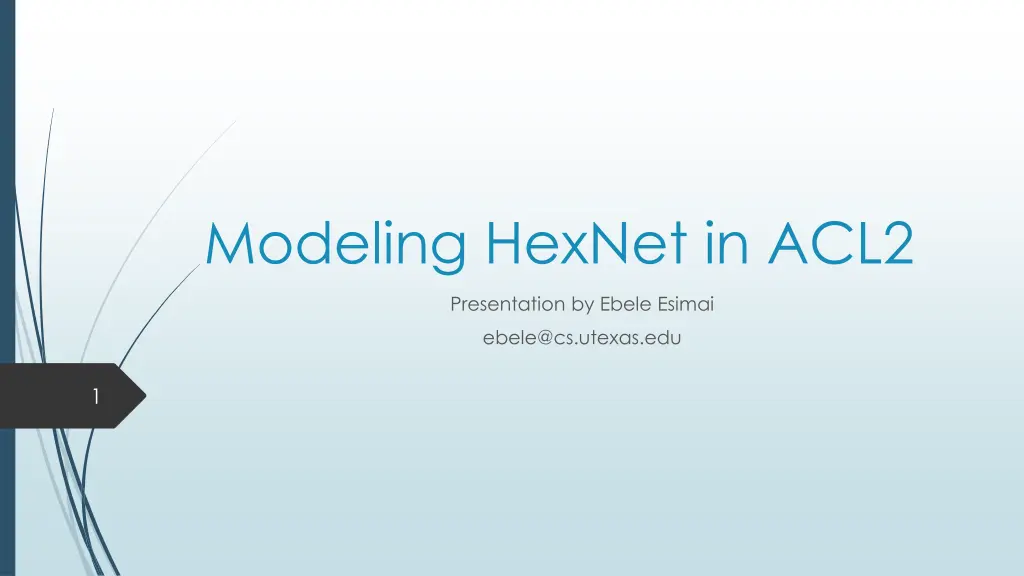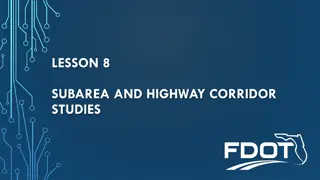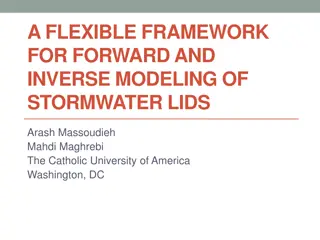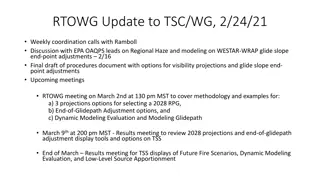
Modeling HexNet in ACL2: Presentation by Ebele Esimai
Explore the implementation of HexNet in ACL2, including its hexagonal topology, network architecture, packet routing, and features such as arbitration and fair decision-making. Follow along as Ebele Esimai presents the high-level description, proof properties, and ACL2 events of this network modeled as a graph with Cartesian addressing.
Download Presentation

Please find below an Image/Link to download the presentation.
The content on the website is provided AS IS for your information and personal use only. It may not be sold, licensed, or shared on other websites without obtaining consent from the author. If you encounter any issues during the download, it is possible that the publisher has removed the file from their server.
You are allowed to download the files provided on this website for personal or commercial use, subject to the condition that they are used lawfully. All files are the property of their respective owners.
The content on the website is provided AS IS for your information and personal use only. It may not be sold, licensed, or shared on other websites without obtaining consent from the author.
E N D
Presentation Transcript
Modeling HexNet in ACL2 Presentation by Ebele Esimai ebele@cs.utexas.edu 1
OUTLINE 2 Introduction into HexNet and its features Implementation in ACL2 Packet movement in a sample network Proof properties Some ACL2 events
HexNet 3 The network plan is based on a hexagonal topology, hence is called HexNet. This hexagonal topology can also be seen in the connections in a brick wall
HexNet 4 Each node in the network is called a JUNCTION. A Junction can either be REPEATER (degree of 3) : This accepts data and forwards it to its appropriate output. DESTINATION (degree of 1) : This is an entry or exit point in the network. Usually, branching and merging in the network is two-way. Therefore, data on only two input links compete for each output link and data on each input link can leave through only two possible output links. Our goal : Modeling the high-level description of this network and packet movement in the network
Features of the network 5 Arbitration : Correct decision behavior when data arrives on two input links at nearly the same time. Also, a mechanism for fairness is needed. W E S
Features of the network 6 Packet Routing: Packet coming through one input link has two possible output links to pass through. This decision is based on the comparison of the final destination and the current junction s location. W E S
Implementation of HexNet in ACL2 7 The network is modeled as a (8 7) (4 7) graph (10 6) (12 6) (0 6) (2 6) Addressing is based on a (8 6) (6 6) (4 6) cartesian grid, as such, each (3 4) (11 4) junction is list of its x coordinate (10 4) (2 4) and its y coordinate (4 3) (8 3) (6 2) There are two links between any (2 2) (0 2) (12 2) (4 2) (8 2) (10 2) two connected junctions to represent data movement in each direction. (6 0)
Implementation of HexNet in ACL2 8 (defconst *network* (8 7) (4 7) ;; junct dest in out (10 6) (12 6) (0 6) (2 6) '(((0 2) ((2 2) S20 S02)) (8 6) (6 6) (4 6) ((2 2) ((0 2) S02 S20) ((4 2) S42 S24) (3 4) (11 4) ((2 4) T24 T42)) (10 4) (2 4) ((4 2) ((2 2) S24 S42) (4 3) (8 3) ((6 2) S64 S46) (6 2) ((4 3) T23 T32)) ((6 2) ((4 2) S46 S64) (2 2) (0 2) (12 2) (4 2) (8 2) (10 2) ((8 2) S86 S68) ((6 0) T02 T20)) ((8 2) ((6 2) S68 S86) (6 0) ((10 2) S108 S810) ((8 3) T83 T38))
Packets 9 A packet is modelled as a list that contains A turn signal, which is the next direction the packet should take An address of final destination of the packet An address of the origin of the packet The information to be passed along The packets are stored on the links. A link can either be full or empty. A linkmap shows the current state of all the links in the network at a given time. Pkt1 Pkt1 - - (E (8 7) (0 2) data) (E (8 7) (0 2) data) E E turn_signal ( (8 8 7 7) ) coordinates of the final destination ( (0 0 2 2) ) coordinates of the origin of the packet (defconst *linkmap* '((S02 (E (12 2) (0 2) data)) (S20) (S24) (S42) (S46) (S64) (S68) (S86) (S810) (S108) (S1012) (S1220) (T20) (T02) (T32) (T23) (T38) (T83 (W (3 4) (8 3) data))
Arbitration in the Model 10 Arbitration is based on the output direction pkt1 pkt1 One of the packets is chosen to proceed while W W E E the second waits pkt2 pkt2 S S
Arbitration in the Model 11 pkt2 Arbitration is based on the output direction pkt3 pkt3 W W E E One of the packets is chosen to proceed while the second waits pkt2 However, to facilitate fairness, the model has to remember the decision at the previous step if S S there is another tie at that junction
Arbitration in the Model 12 (defun arbiter (outlink inputs st) Arbitration is based on the output direction (cond ((atom inputs) (mv nil st)) One of the packets is chosen to proceed while the second waits ((atom (cdr inputs)) (mv (car inputs) st)) (t (let* ((entry (assoc-eq outlink st)) However, to facilitate fairness, the model has to remember the decision at the previous step if there is another tie at that junction (pref (cdr entry))) (if (and pref (member-eq pref inputs)) (let* ((new-pref (car (remove-eq pref inputs))) Outlink link in the output direction (new-st (update-alist outlink new-pref st))) (mv pref new-st)) Inputs links with packets (let* ((new-pref (cadr inputs)) St statemap that stores previous step decisions (new-st (update-alist outlink new-pref st))) (mv (car inputs) new-st)))))))
Packet Routing 13 The network uses Advanced Address Decoding This means that the routing function calculates the next direction, i.e. turn-signal, a step before it makes the turn. pkt1 curr dest1 Comparison is made between the final destination of the packet and the address of next junction. dest2 Turn_signal (pkt1) = East => Turn_signal (pkt1) = East => curr curr Routing_function (dest1 dest2 Routing_function (dest1 dest2 curr = (compare curr final) => East or South curr final g) final g)
(defun routing routing- -normal normal (dest1 dest2 curr final g) Routing Packet Traffic (let* ((dest1-x (car dest1)) (dest1-y (cadr dest1) (dest2-x (car dest2)) (dir dir1 1 (get-direction curr dest1 g)) (dir dir2 2 (get-direction curr dest2 g)) 14 (curr-x (car curr)) (curr-y (cadr curr)) (final-x (car final)) (final-y (cadr final))) (if (isTerminal dest1 curr g) (if (equal dest1 final) dir dir1 1 (if (isTerminal dest2 curr g) (if (equal dest2 final) dir dir2 2 (cw "Bad route ")) pkt1 curr dir dir2 2)) dest1 (if (isTerminal dest2 curr g) (if (equal dest2 final) dir dir2 2 dir dir1 1) (cond ((< curr-y final-y) (if (< curr-y dest1-y) dir dir1 1 dir dir2 2)) ((> curr-y final-y) (if (> curr-y dest1-y) dir dir1 1 dir dir2 2)) dest2 ((< curr-x final-x) (if (< dest1-x dest2-x) dir dir2 2 dir dir1 1)) ((> curr-x final-x) (if (< dest1-x dest2-x) dir dir1 1 dir dir2 2)))))))
Example 15 (6 8) Linkmap before execution (8 7) (4 7) (S02 (E (12 2) (0 2) data)) (10 6) (12 6) (0 6) (2 6) (T83 (W (3 4) (8 3) data)) (8 6) (6 6) (4 6) (T68 (E (12 2) (6 8) data)) (3 4) (11 4) (10 4) (2 4) (4 3) (8 3) pkt3 pkt1 (6 2) (2 2) (0 2) (12 2) (4 2) (8 2) (10 2) (6 0)
Example 16 Linkmap before execution (6 8) (S02 (E (12 2) (0 2) data)) (8 7) (4 7) (T83 (W (3 4) (8 3) data)) (10 6) pkt2 (12 6) (0 6) (2 6) (T68 (E (12 2) (6 8) data)) (8 6) (6 6) (4 6) Linkmap after 1 step (3 4) (11 4) (10 4) (2 4) (S24 (E (12 2) (0 2) DATA)) (4 3) (8 3) (S86 (W (3 4) (8 3) DATA)) pkt1 (6 2) (S686 (E (12 2) (6 8) DATA)) pkt3 (2 2) (0 2) (12 2) (4 2) (8 2) (10 2) (6 0)
Example 17 Linkmap before execution (6 8) (S02 (E (12 2) (0 2) data)) (8 7) (4 7) (T83 (W (3 4) (8 3) data)) (10 6) pkt2 (T68 (E (12 2) (6 8) data)) (12 6) (0 6) (2 6) (8 6) (6 6) (4 6) Linkmap after 1 step (3 4) (11 4) (S24 (E (12 2) (0 2) DATA)) (10 4) (2 4) (S86 (W (3 4) (8 3) DATA)) (4 3) (8 3) (S686 (E (12 2) (6 8) DATA)) (6 2) pkt1 (2 2) (0 2) Linkmap after 2 steps (12 2) pkt3 (4 2) (8 2) (10 2) (S46 (E (12 2) (0 2) DATA)) (S64 (W (3 4) (8 3) DATA)) (6 0) (S610 (S (12 2) (6 8) DATA))
Example Linkmap before execution 18 (S02 (E (12 2) (0 2) data)) (T83 (W (3 4) (8 3) data)) (6 8) (T68 (E (12 2) (6 8) data)) (8 7) (4 7) Linkmap after 1 step (10 6) (12 6) (0 6) (2 6) (S24 (E (12 2) (0 2) DATA)) (8 6) (S86 (W (3 4) (8 3) DATA)) (6 6) (4 6) (S686 (E (12 2) (6 8) DATA)) pkt2 (3 4) (11 4) (10 4) Linkmap after 2 steps (2 4) (S46 (E (12 2) (0 2) DATA)) (4 3) (8 3) (S64 (W (3 4) (8 3) DATA)) pkt 1 (S610 (S (12 2) (6 8) DATA)) (6 2) (2 2) (0 2) (12 2) pkt3 (4 2) (8 2) (10 2) Linkmap after 3 steps (S68 (E (12 2) (0 2) DATA)) (S42 (N (3 4) (8 3) DATA)) (6 0) (T106 (S (12 2) (6 8) DATA))
Example Linkmap before execution (S02 (E (12 2) (0 2) data)) (T83 (W (3 4) (8 3) data)) 19 (T68 (E (12 2) (6 8) data)) (6 8) Linkmap after 1 step (S24 (E (12 2) (0 2) DATA)) (8 7) (4 7) (S86 (W (3 4) (8 3) DATA)) (S686 (E (12 2) (6 8) DATA)) (10 6) (12 6) (0 6) (2 6) Linkmap after 2 steps (8 6) (6 6) (4 6) (S46 (E (12 2) (0 2) DATA)) (S64 (W (3 4) (8 3) DATA)) (3 4) (S610 (S (12 2) (6 8) DATA)) (11 4) (10 4) (2 4) Linkmap after 3 steps pkt2 (4 3) (8 3) pkt3 (S68 (E (12 2) (0 2) DATA)) (S42 (N (3 4) (8 3) DATA)) (6 2) pkt1 (T106 (S (12 2) (6 8) DATA)) Linkmap after 4 steps (2 2) (0 2) (12 2) (4 2) (8 2) (10 2) (S810 (E (12 2) (0 2) DATA)) (T42 (E (3 4) (8 3) DATA)) (6 0) (T104 (E (12 2) (6 8) DATA))
Example Linkmap after 4 steps (S810 (E (12 2) (0 2) DATA)) 20 (T42 (E (3 4) (8 3) DATA)) (6 8) (T104 (E (12 2) (6 8) DATA)) (8 7) (4 7) (10 6) (12 6) Linkmap after 5 steps (0 6) (2 6) (S1012 (DONE (12 2) (0 2) DATA)) (8 6) (6 6) (4 6) (S23 (DONE (3 4) (8 3) DATA)) pkt3 (11 4) (T104 (E (12 2) (6 8) DATA)) (10 4) (3 4) (2 4) The statemap records that preference should be given to pkt2 if there is a tie in the next step. (4 3) (8 3) pkt2 (6 2) pkt1 (S1012 . T104) (2 2) (0 2) (12 2) (4 2) (8 2) (10 2) (6 0)
Example Linkmap after 4 steps (S810 (E (12 2) (0 2) DATA)) 21 (T42 (E (3 4) (8 3) DATA)) (6 8) (T104 (E (12 2) (6 8) DATA)) (8 7) (4 7) (10 6) (12 6) Linkmap after 5 steps (0 6) (2 6) (S1012 (DONE (12 2) (0 2) DATA)) (8 6) (6 6) (4 6) (S23 (DONE (3 4) (8 3) DATA)) (11 4) (T104 (E (12 2) (6 8) DATA)) (10 4) (3 4) (2 4) The statemap records that preference should be given to pkt2 if there is a tie in the next step. (4 3) (8 3) pkt2 (6 2) (S1012 . T104) Linkmap after 6 steps (2 2) (0 2) (12 2) (4 2) (8 2) (10 2) (S1012 (DONE (12 2) (6 8) DATA)) (6 0)
Proof Properties 22 Reachability: Every information source can send data to every destination. Diameter: The number of steps that the communication from source to destination will take
(defun update update- -link link (junct dest lt st g) Calculates update for the next link (let* ((outlink (outlink-lookup junct dest g))) (if (cdr (assoc-eq outlink lt)) 23 (if (equal (car (cadr (assoc-eq outlink lt))) 'Done) (let ((new-lt (update-alist outlink nil lt))) (mv new-lt st)) (mv lt st)) (let* ((stack (remove-equal dest (sources junct g))) (inputs (current-inputs junct dest stack lt g))) (if (endp inputs) (mv lt st) (let* ((result (mv-list 2 (oracle outlink inputs st))) (input (car result)) (new-st (cadr result))) (if (atom (cdr (assoc-eq input lt))) (mv nil nil) (let* ((pkt (cadr (assoc-eq input lt))) (final (cadr pkt)) (turn_signal (routing junct dest final g))) (if turn_signal (let* ((new-pkt (cons turn_signal (cdr pkt))) (new-link-state (update-alist outlink (list new-pkt) lt)) (new-lt (update-alist input nil new-link-state))) (mv new-lt new-st)) (mv nil nil))))))))))
(defun step step- -junct junct (junct neighbors lt st g) Updates all output links in a junction (if (endp neighbors) 24 (mv lt st) (let ((dest (car neighbors))) (if (junctp dest g) (let* ((result (mv-list 2 (update-link junct dest lt st g))) (new-lt (car result)) (new-st (cadr result))) (step-junct junct (cdr neighbors) new-lt new-st g)) (mv nil nil))))) (defun run run (juncts lt st g) Updates the Junctions by a step (if (endp juncts) (mv lt st) (let* ((junct (car juncts)) (neighbors (sources junct g)) (result (mv-list 2 (step-junct junct neighbors lt st g))) (new-lt (car result)) (new-st (cadr result))) (run (cdr juncts) new-lt new-st g))))






















